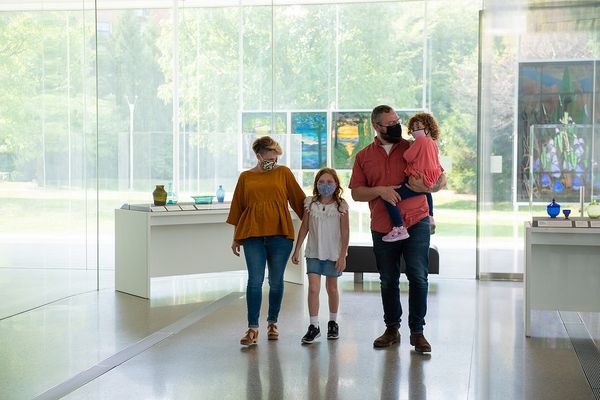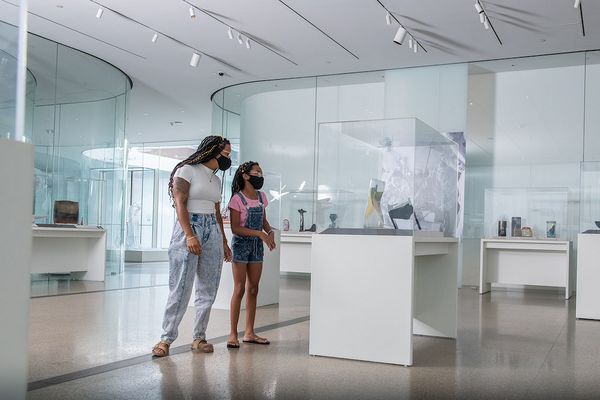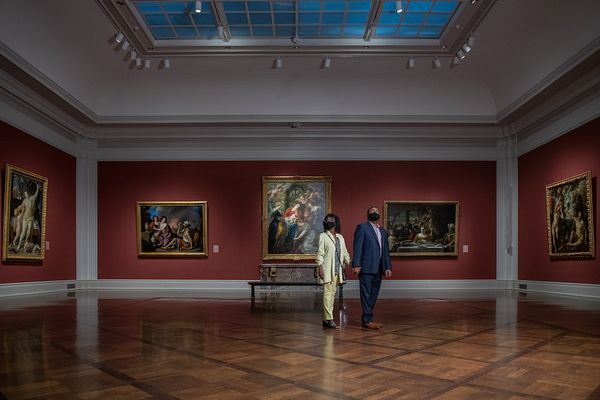Installation view. Courtesy of Toledo Museum of Art.
You started your tenure in April 2020, right after we had locked down due to COVID. How has the pandemic affected your thinking?
COVID’s impact on society is almost beyond description. The breadth of global infections and death, the impact on psychological wellness, and the financial dislocations are staggering. Against such a traumatic backdrop, it is inappropriate, I think, to discuss ‘silver linings.’ However, wherever there are challenges, there are also opportunities.
One might think that beginning a directorship amid a pandemic would be a disadvantage, but I was fortunate to have served in various roles at the Toledo Museum of Art (TMA) for six years previously; that experience helped me immensely during my transition. Even so, I was new in the director role, which allowed us to launch a strategic planning process in May. The ruptures of COVID necessitated that we think in blue sky ways about how TMA should operate.

Museum exterior. Courtesy of Toledo Museum of Art.
Our point of view is that COVID has accelerated changes already under way—towards greater adoption of digital platforms, for example—but that the interruption COVID has introduced is, fundamentally, temporary. We believe, and this is borne out by survey data, that demand for in‐person experiences with art will return, visitors will come back, and we need to be prepared to serve them.
COVID made clear for all museums the importance of the local/regional audience, and we are already fortunate to have exceptional regional visitation at the Toledo Museum of Art. Before the pandemic, on any given day four of every five visitors to the Museum is from our region, which makes it all the more remarkable that in a city of 275,000 and a metro area of 650,000, the Toledo Museum of Art averages 385,000 visitors per year. TMA’s annual attendance makes us one of the top five visited art museums per capita in the United States.
Serving our local audience more holistically and synchronizing local topicality with programming of international significance is the core of our strategy. TMA will do major shows of interest anywhere but built around themes that resonate with issues particularly relevant here, in Northwest Ohio.

Courtesy of Toledo Museum of Art.
One way the Museum has served its community has been to remain open throughout this fall's COVID surge. You wrote an op‐ed explaining the important role museums can play in the pandemic and why they should remain open, to the extent they can. Can you explain briefly for our readers your thinking?
Like all museums, the Toledo Museum of Art shut down in mid‐March. Since we re‐opened in late June, we have avoided having to again close our doors. Rigorous safety protocols—designed in consultation with infectious disease experts—have been put in place. Mask wearing and social distancing in the galleries are mandated. There are limits on the number of people allowed in our buildings at any given time. TMA is doing many of the things most museums do.
What we did that may be somewhat different is that we also commissioned an air quality survey. We knew we had exceptional air handling to maintain temperature and humidity in our galleries, but we wanted to assess just how clean our air was. We engaged an industrial hygienist who visited TMA during open hours and found there was no detectable particulate matter in our air. The Museum, with its thirty‐foot ceilings and spaces ready‐made for social distancing feels safe as it is; we validated that the Museum is empirically safe. It should be no surprise, then, that we have had zero cases of community transmission since COVID began.
We felt our obligation to our community was to open our galleries as a reprieve and refuge.
So here we are, knowing we have a safe space and knowing that people desperately need safe activities for their mental wellness. Study after study has demonstrated the stress COVID has induced, just as study after study has demonstrated the mental wellness benefits of visiting museums. The evidence that museums de‐stress is so rigorous that in some countries one can receive an anti‐depression or anti‐anxiety prescription for a museum visit.
The Toledo Museum of Art is a free museum—we do not charge admission and have not done so since our main building opened in 1912—and as the weather turned cold and people couldn’t be outside, we felt our obligation to our community was to open our galleries as a reprieve and refuge from our volatile and uncertain world.
People are taking advantage of TMA as a space for solace and reflection. Eighty percent of visitors since our reopening are not TMA members, and since Thanksgiving, average visitation is up about 20%. We continue to have no cases of COVID transmission.

Courtesy of Toledo Museum of Art.
Let’s switch to what people are seeing when they visit the Museum. Toledo is known for a collection that is near‐encyclopedic in scope. How, if at all, are you thinking about the collection in light of COVID and as part of your strategy?
The collection of the Toledo Museum of Art represents 5000 years of human history across six continents, but we have never sought to be encyclopedic. Rather, the institution has always sought artworks of the highest quality. It is not uncommon to find someone who is skeptical of the notion of quality, but I’ve never seen any such person visit and fail to be floored by our holdings. Work‐for‐work, the Toledo Museum of Art’s collection is truly exceptional and speaks for itself.
This notion of quality, and its relationship to encyclopedism, is important to unpack and is central to TMA’s strategy. Quality has rightly been critiqued, though our view is that such a critique is not inherent to the notion of quality; instead, the issue is with how the notion of quality has been leveraged. Museums have largely refracted quality through a Eurocentric lens, reinforcing colonialist paradigms of knowledge—whether that is in the superiority of Western over non‐Western art (themselves problematic categories), painting and sculpture over craft, etc.

Courtesy of Toledo Museum of Art.
But quality is, at is core, fundamentally egalitarian and inclusive. Quality does not care what you look like, where you are from, where you went to art school or if you went to art school. If we can broaden the aperture of what we consider quality using a relativist aesthetics—what I like to call “seeking beauty without bias”—then we can add to TMA’s core collection in a way that is more inclusive and offer our audience a truly global, and more accurate, art history.
Contemporary art is an important part of this broadening, but at TMA we are committed to building our historical collection in equal measure. We want visitors to see themselves reflected in our collection, but we are as interested in having visitors see their histories told. As such, the major project of this strategic plan is a wholesale reinstallation of the Museum’s permanent collection—the first in nearly 40 years—which we plan to complete by 2026.
COVID, which has spread across the world, has reminded us of the effects of globalization; but globalization has a history, and we seek to tell it in Toledo with and through the highest quality works of art from cultures currently represented in our collection and many that we will seek to acquire over the next five years.

Recommened Reading
Executive Director Cybele Maylone on What's Next for the Aldrich Contemporary Art Museum >
Curator Erica Warren on What's Next for the Art Institute of Chicago >
